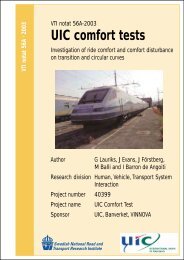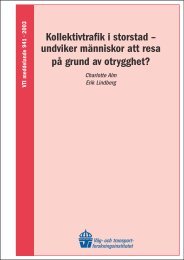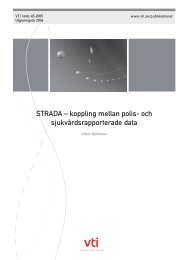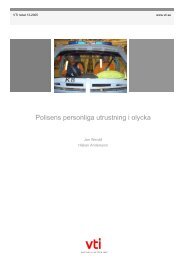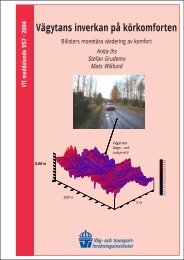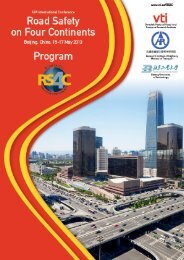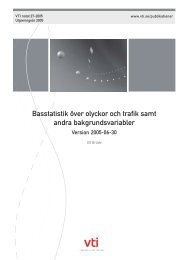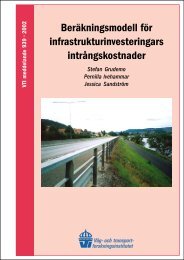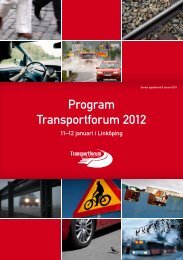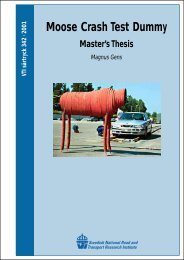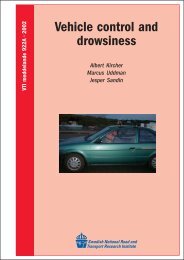Friction measurement methods and the correlation between road - VTI
Friction measurement methods and the correlation between road - VTI
Friction measurement methods and the correlation between road - VTI
You also want an ePaper? Increase the reach of your titles
YUMPU automatically turns print PDFs into web optimized ePapers that Google loves.
0,70,60,50,40,30,20,10Dense asphalt Surface dressing Porous asphalt197519841998Figure 3.2 <strong>Friction</strong> coefficient measured with three different batches of PIARCtest tyres [10]<strong>Friction</strong> values are very sensitive to <strong>the</strong> tyre used <strong>and</strong> even apparently identicalsamples from two different batches of a st<strong>and</strong>ardised tyre can produce differentfriction results, maybe not large differences but significant. The reasons for thatare for example small differences in <strong>the</strong> tyre rubber composition <strong>and</strong> maybe alsosmall differences in tyre geometry. For most manufacturers <strong>the</strong> market forst<strong>and</strong>ardised test tyres is very small compared to <strong>the</strong>ir o<strong>the</strong>r products <strong>and</strong> <strong>the</strong>reforetest tyres are normally produced in larger batches say every fourth year <strong>and</strong> alsooften by different producers. KOAC, WMD (Dutch Road Research Laboratories)[10] has compared PIARC test tyres from <strong>the</strong> batches 1975, 1984 <strong>and</strong> 1998 <strong>and</strong>found differences in <strong>the</strong> friction values partly explained by differences in <strong>the</strong>compound chemistry, see figure 3.2. In <strong>the</strong> case of <strong>the</strong> 1975 tyres <strong>the</strong> difference isquite large which in <strong>the</strong> Ne<strong>the</strong>rl<strong>and</strong>s also led to <strong>the</strong> introduction of a frictioncorrection formula.According to investigations by Henry [22] <strong>and</strong> Bachmann [12] <strong>the</strong> ribbed <strong>and</strong>smooth st<strong>and</strong>ard test tyres (ASTM <strong>and</strong> PIARC) have a lower friction coefficienton a normal wet <strong>road</strong> than a commercial passenger car tyre. As water depth isincreased, <strong>the</strong> ribbed test tyre increases in performance <strong>and</strong> was found to givehigher friction values than a slightly worn normal passenger car tyre.<strong>Friction</strong> of <strong>the</strong> <strong>road</strong> pavement is usually evaluated in <strong>the</strong> summer period. Thereis a seasonal variation that has to be considered. The wet friction of a specificpavement is normally higher in <strong>the</strong> spring than in <strong>the</strong> autumn [23; 27] due to adepolishing effect from <strong>the</strong> snow removal activities <strong>and</strong> <strong>the</strong> studded tyres.During <strong>the</strong> winter period <strong>the</strong>re is a risk that <strong>the</strong> water spread during <strong>the</strong> wetfriction <strong>measurement</strong> freezes. The pavement can also be covered with snow or ice.<strong>Friction</strong> <strong>measurement</strong>s during winter are <strong>the</strong>refore typically aimed at wintermaintenance evaluation.<strong>VTI</strong> meddel<strong>and</strong>e 911A 11



